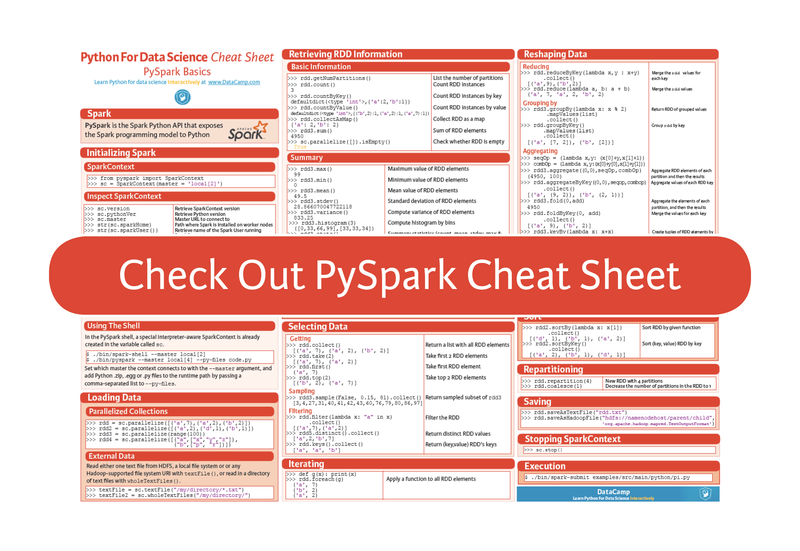- Spark Sql Functions Cheat Sheet
- Spark Sql Cheat Sheet
- Spark Sql Cheat Sheet Scala
- Sql Quick Reference Sheet
- Sql Query Cheat Sheet Pdf
- Pyspark Cheat Sheet
- SQL Cheat Sheet
- Background: What is SQL? Why do we need it?
- Managing Tables
- Manipulating Data
- Retrieving Attributes
- JOINS
- Subqueries
- Using Functions to Customize ResultSet
- GROUPING DATA
The Google Cloud Developer's Cheat Sheet All Products Compute Storage Database Data and Analytics Hybrid and Multi-cloud AI/ML Networking Internet of Things (IoT) Gaming Identity and Security Management Tools Developer Tools Migration to GCP API Platform and Ecosystems Google Maps Platform Workspace Platform Mobile (Firebase) Additional. SQL Cheat Sheet Background: What is SQL? Why do we need it? SQL is a database language used to query and manipulate the data in the database. Main objectives: To provide an efficient and convenient environment; Manage information about users who interact with the DBMS; The SQL statements can be categorized as. Data Definition Language(DDL.
SQL Cheat Sheet
Background: What is SQL? Why do we need it?
SQL is a database language used to query and manipulate the data in the database.
Main objectives:
- To provide an efficient and convenient environment
- Manage information about users who interact with the DBMS
Apache Spark Cheat sheet Here is a cheat sheet for Apache Spark for various operations like transformation, actions, persistence methods, additional transformation & actions, extended RDD, streaming transformation, RDD persistence, etc. Hive Function Cheat Sheet In this cheat sheet, get commands for Hive functions. Spark SQL provides an implicit conversion method named toDF, which creates a DataFrame from an RDD of objects represented by a case class. Spark SQL infers the schema of a dataset. The toDF method is not defined in the RDD class, but it is available through an implicit conversion.
The SQL statements can be categorized as

Data Definition Language(DDL) Commands:
- CREATE: creates a new database object, such as a table.
- ALTER: used to modify the database object
- DROP: used to delete the objects.
Data Manipulation Language(DML) Commands:
- INSERT: used to insert a new data row record in a table.
- UPDATE: used to modify an existing record in a table.
- DELETE: used delete a record from the table.
Data Control Language(DCL) Commands:
- GRANT: used to assign permission to users to access database objects.
- REVOKE: used to deny permission to users to access database objects.
Data Query Language(DQL) Commands:
- SELECT: it is the DQL command to select data from the database.
Data Transfer Language(DTL) Commands:
- COMMIT: used to save any transaction into the database permanently.
- ROLLBACK: restores the database to the last committed state.
Identifying Data Types
Data types specify the type of data that an object can contain, such as integer data or character data. We need to specify the data type according to the data to be stored.
Following are some of the essential data types:
| Data Type | Used to Store |
| int | Integer data |
| smallint | Integer data |
| tinyint | Integer data |
| bigint | Integer data |
| decimal | Numeric data type with a fixed precision and scale. |
| numeric | numeric data type with a fixed precision and scale. |
| float | floating precision data |
| money | monetary data |
| datetime | data and time data |
| char(n) | fixed length character data |
| varchar(n) | variable length character data |
| text | character string |
| bit | integer data with 0 or 1 |
| image | variable length binary data to store images |
| real | floating precision number |
| binary | fixed length binary data |
| cursor | cursor reference |
| sql_variant | different data types |
| timestamp | unique number in the database that is updated every time in a row that contains timestamp is inserted or updated. |
| table | temporary set of rows returned as a result set of a table-valued function. |
| xml | store and return xml values |
Managing Tables
Create Table
Table can be created using the CREATE TABLE statement. The syntax is as follows:
Example: Create a table named EmployeeLeave in Human Resource schema with the following attributes:
| Columns | Data Type | Checks |
| EmployeeID | int | NOT NULL |
| LeaveStartDate | date | NOT NULL |
| LeaveEndDate | date | NOT NULL |
| LeaveReason | varchar(100) | NOT NULL |
| LeaveType | char(2) | NOT NULL |
Constraints in SQL
Constraints define rules that must be followed to maintain consistency and correctness of data. A constraint can be created by using either of the following statements:
Types of Constraints:
| Constraint | Description | Syntax |
| Primary key | Columns or columns that uniquely identify all rows in the table. | CREATE TABLE table_name ( col_name [CONSTRAINT constraint_name PRIMARY KEY] (col_name(s)) ) |
| Unique key | Enforces uniqueness on non primary key columns. | |
| Foreign key | Is used to remove the inconsistency in two tables when the data depends on other tables. | |
| Check | Enforce domain integrity by restricting the values to be inserted in the column. |
3.2 Modifying Tables
Modify table using ALTER TABLE statement when:
- Adding column
- Altering data type
- Adding or removing constraints
Syntax of ALTER TABLE:
Renaming a Table
A table can be renamed whenever required using RENAME TABLE statement:
RENAME TABLE old_table_name TO new_table_name;
Dropping a Table versus Truncate Table
A table can be dropped or deleted when no longer required using DROP TABLE statement:
The contents of the table can be deleted when no longer required without deleting the table itself using TRUNCATE TABLE statement:
Manipulating Data
Storing Data in a Table
Syntax:
Example: Inserting data into Student table.
Example: Inserting multiple data into Student table.
Copying Data from one table to another:
Updating Data in a Table
Data can be updated in the table using UPDATE DML statement:
Example update marks of Andy to 85
Deleting Data from a Table
A row can be deleted when no longer required using DELETE DML statement.
Syntax:
Deleting all records from a table:
Retrieving Attributes
One or more column can be displayed while retrieving data from the table.
One may want to view all the details of the Employee table or might want to view few columns.
Required data can be retrieved data from the database tables by using the SELECT statement.
The syntax of SELECT statement is:
Consider the following Student table:
| StudentID | FirstName | LastName | Marks |
| 101 | John | Ray | 78 |
| 102 | Steve | Jobs | 89 |
| 103 | Ben | Matt | 77 |
| 104 | Ron | Neil | 65 |
| 105 | Andy | Clifton | 65 |
| 106 | Park | Jin | 90 |
Retrieving Selected Rows
To retrieve selected rows from a table use WHERE clause in the SELECT statement.
HAVING Clause is used instead of WHERE for aggregate functions.
Comparison Operators
Comparison operators test for the similarity between two expressions.
Syntax:
Example of some comparison operators:
Logical Operators
Logical operators are used to SELECT statement to retrieve records based on one or more conditions. More than one logical operator can be combined to apply multiple search conditions.
Syntax:
Types of Logical Operators:
OR Operator
AND Operator
NOT Operator

Range Operator
Range operator retrieves data based on range.
Syntax:
Types of Range operators:
BETWEEN
NOT BETWEEN
Retrieve Records That Match a Pattern
Data from the table can be retrieved that match a specific pattern.
The LIKE keyword matches the given character string with a specific pattern.
Displaying in a Sequence
Use ORDER BY clause to display the data retrieved in a specific order.
Displaying without Duplication
The DISTINCT keyword is used to eliminate rows with duplicate values in a column.
Syntax:
JOINS
Joins are used to retrieve data from more than one table together as a part of a single result set. Two or more tables can be joined based on a common attribute.
Types of JOINS:
Consider two tables Employees and EmployeeSalary
| EmployeeID (PK) | FirstName | LastName | Title |
| 1001 | Ron | Brent | Developer |
| 1002 | Alex | Matt | Manager |
| 1003 | Ray | Maxi | Tester |
| 1004 | August | Berg | Quality |
| EmployeeID (FK) | Department | Salary |
| 1001 | Application | 65000 |
| 1002 | Digital Marketing | 75000 |
| 1003 | Web | 45000 |
| 1004 | Software Tools | 68000 |
INNER JOIN
An inner join retrieves records from multiple tables by using a comparison operator on a common column.
Syntax:
Example:
OUTER JOIN
An outer join displays the resulting set containing all the rows from one table and the matching rows from another table.
An outer join displays NULL for the column of the related table where it does not find matching records.
Syntax:
Types of Outer Join
LEFT OUTER JOIN: In left outer join all rows from the table on the left side of the LEFT OUTER JOIN keyword is returned, and the matching rows from the table specified on the right side are returned the result set.
Example:
RIGHT OUTER JOIN: In right outer join all rows from the table on the right side of the RIGHT OUTER JOIN keyword are returned, and the matching rows from the table specified on the left side are returned is the result set.
Example:
FULL OUTER JOIN: It is a combination of left outer join and right outer join. This outer join returns all the matching and non-matching rows from both tables. Whilst, the matching records are displayed only once.
Example:
CROSS JOIN
Also known as the Cartesian Product between two tables joins each row from one table with each row of another table. The rows in the result set is the count of rows in the first table times the count of rows in the second table.
Syntax:
EQUI JOIN
Spark Sql Functions Cheat Sheet
An Equi join is the same as inner join and joins tables with the help of foreign key except this join is used to display all columns from both tables.
SELF JOIN
In self join, a table is joined with itself. As a result, one row is in a table correlates with other rows in the same table. In this join, a table name is mentioned twice in the query. Hence, to differentiate the two instances of a single table, the table is given two aliases. Syntax:
Subqueries
An SQL statement that is used inside another SQL statement is termed as a subquery.
They are nested inside WHERE or HAVING clause of SELECT, INSERT, UPDATE and DELETE statements.
- Outer Query: Query that represents the parent query.
- Inner Query: Query that represents the subquery.
Using IN Keyword
If a subquery returns more than one value, we might execute the outer query if the values within the columns specified in the condition match any value in the result set of the subquery.
Syntax:
Using EXISTS Keyword
EXISTS clause is used with subquery to check if a set of records exists.
TRUE value is returned by the subquery in case if the subquery returns any row.
Syntax:
Using Nested Subqueries
A subquery can contain more than one subqueries. Subqueries are used when the condition of a query is dependent on the result of another query, which is, in turn, is dependent on the result of another subquery.
Syntax:
Correlated Subquery
A correlated subquery can be defined as a query that depends on the outer query for its evaluation.
Using Functions to Customize ResultSet
Various in-built functions can be used to customize the result set.
Syntax:
Using String Functions
String values in the result set can be manipulated by using string functions.
They are used with char and varchar data types.
Following are the commonly used string functions are:
| Function Name | Example |
| left | |
| len | |
| lower | |
| reverse | |
| right | |
| space | |
| str | |
| substring | |
| upper |
Using Date Functions
Date functions are used to manipulate date time values or to parse the date values.
Date parsing includes extracting components, such as day, month, and year from a date value.
Some of the commonly used date functions are:
| Function Name | Parameters | Description |
| dateadd | (date part, number, date) | Adds the number of date parts to the date. |
| datediff | (date part, date1, date2) | Calculates the number of date parts between two dates. |
| Datename | (date part, date) | Returns date part from the listed as a character value. |
| datepart | (date part, date) | Returns date part from the listed as an integer. |
| getdate | 0 | Returns current date and time |
| day | (date) | Returns an integer, which represents the day. |
| month | (date) | Returns an integer, which represents the month. |
| year | (date) | Returns an integer, which represents the year. |
Using Mathematical Functions
Numeric values in a result set can be manipulated in using mathematical functions.
The following table lists the mathematical functions:
| Function Name | Parameters | Description |
| abs | (numeric_expression) | Returns an absolute value |
| acts,asin,atan | (float_expression) | Returns an angle in radians |
| cos, sin, cot,tan | (float_expression) | Returns the cosine, sine, cotangent, or tangent of the angle in radians. |
| degrees | (numeric_expression) | Returns the smallest integer greater than or equal to specifies value. |
| exp | (float_expression) | Returns the exponential value of the specified value. |
| floor | (numeric_expression) | Returns the largest integer less than or equal to the specified value. |
| log | (float_expression) | Returns the natural logarithm of the specified value. |
| pi | 0 | Returns the constant value of 3.141592653589793 |
| power | (numeric_expression,y) | Returns the value of numeric expression to the value of y |
| radians | (numeric_expression) | Converts from degrees to radians. |
| rand | ([seed]) | Returns a random float number between 0 and 1. |
| round | (numeric_expression,length) | Returns a numeric expression rounded off to the length specified as an integer expression. |
| sign | (numeric_expression) | Returns positive, negative or zero. |
| sqrt | (float_expression) | Returns the square root of the specified value. |
Using Ranking Functions
Ranking functions are used to generate sequential numbers for each row to give a rank based on specific criteria.

Ranking functions return a ranking value for each row. Following functions are used to rank the records:
- row_number Function: This function returns the sequential numbers, starting at 1, for the rows in a result set based on a column.
- rank Function: This function returns the rank of each row in a result set based on specified criteria.
- dense_rank Function: The dense_rank() function is used where consecutive ranking values need to be given based on specified criteria.
These functions use the OVER clause that determines the ascending or descending sequence in which rows are assigned a rank.
Using Aggregate Functions
The aggregate functions, on execution, summarize the values for a column or group of columns and produce a single value.
Syntax:
Following are the aggregate functions:
Spark Sql Cheat Sheet
| Function Name | Description |
| avg | returns the average of values in a numeric expression, either all or distinct. |
| count | returns the number of values in an expression, either all or distinct. |
| min | returns the lowest value in an expression. |
| max | returns the highest value in an expression. |
| sum | returns the total of values in an expression, either all or distinct. |
GROUPING DATA
Grouping data means to view data that match a specific criteria to be displayed together in the result set.
Data can be grouped by using GROUP BY, COMPUTE,COMPUTE BY and PIVOT clause in the SELECT statement.
GROUP BY Clause
Summarizes the result set into groups as defined in the query by using aggregate functions.
Syntax:
COMPUTE and COMPUTE BY Clause
This COMPUTE clause, with the SELECT statement, is used to generate summary rows by using aggregate functions in the query result.
The COMPUTE BY clause can be used to calculate summary values of the result set on a group of data.
Syntax:
PIVOT Clause
The PIVOT operator is used to transform a set of columns into values, PIVOT rotates a table-valued expression by turning the unique values from one column in the expression into multiple columns in the output.
Syntax:
People are also reading:
Having a good cheatsheet at hand can significantly speed up the development process.One of the best cheatsheet I have came across is sparklyr’s cheatsheet.
For my work, I’m using Spark’s DataFrame API in Scala to create data transformation pipelines. These are some functions and design patterns that I’ve found to be extremely useful.

Spark Sql Cheat Sheet Scala
Load data
Sql Quick Reference Sheet
Get SparkContext information
Get Spark version
Sql Query Cheat Sheet Pdf
Get number of partitions
Count number of rows
Print schema
Preview top 20 rows
Design pattern for constructing as data transformation pipeline
Drop duplicate rows
For an exhaustive list of the functions, you can check out the Spark’s Dataset class documentation.
Pyspark Cheat Sheet
Hope you’ve found this cheatsheet useful. Thank you!
